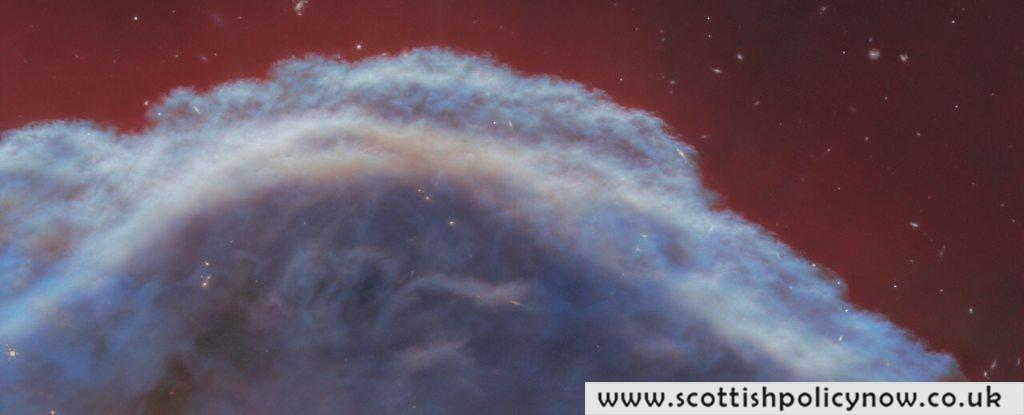A groundbreaking perspective of one of the most iconic figures in the celestial sphere has recently been unveiled.
The James Webb Space Telescope’s mid- and near-infrared observations have unveiled unprecedented features within the cosmic formation known as the Horsehead Nebula. An exquisitely detailed image shows the telescope’s focus on the upper section of the ‘horse’s’ head, revealing filaments and tendrils with remarkable clarity.
Utilizing 23 different filters, astronomers have achieved such refined resolution that it is possible to observe emissions from particles smaller than 20 nanometers, including interstellar polycyclic aromatic hydrocarbons, alongside light scattered by larger grains and ionized hydrogen within the nebula.

Dubbed for its equine-like silhouette, the Horsehead Nebula is a prominent cloud located about 1,300 light-years away, nestled within the Orion molecular cloud complex. It is densely packed with dust and gas, appearing nearly as opaque as shadows in visible light and often seems like a void in the luminescent gas that surrounds it.
When examined up close or viewed in wavelengths beyond human vision, the nebula transforms from a dark abyss into a radiant, undulating cloud. Although the Horsehead Nebula lacks its own light source, it is warmed by Sigma Orionis, a nearby cluster of young, massive, and intensely hot stars, which blaze at temperatures about 34,600 Kelvin.
This set of characteristics renders the Horsehead Nebula an ideal natural laboratory for exploring the birthplaces of stars. The ‘horsehead’ shape itself is a condensed mass of material collapsing under its own gravity, enveloping nascent stars that remain hidden behind the dust.
However, the fierce radiation from neighboring stars profoundly impacts the surrounding material. Intense ultraviolet light induces photodissociation, splitting molecules under its brutal influence and creating a predominantly neutral interstellar medium around the nebula, known as a photodissociation region (PDR), which the JWST’s images will further investigate.
These observations also shed light on the photoevaporation process, where gas is ionized by potent light and effectively evaporates.
So far, these images have enabled scientists to delineate the intricate small-scale structures along the illuminated edge of the Horsehead Nebula and a series of filaments that run perpendicular to the face of the PDR. This structure comprises dust and gas that are part of the photoevaporative flow.
Yet, this is merely the start. The forthcoming step involves a thorough analysis of the emitted light to discern the chemical properties of the dust and gas, as well as the size and movement of the dust particles based on the scattering of light. This analysis aims to create a detailed model of dust evolution within the PDR and assist researchers in understanding how these clouds transform and evaporate, ultimately liberating the nascent stars enclosed within.
The inaugural paper has been accepted for publication in Astronomy & Astrophysics and is currently accessible on arXiv.








